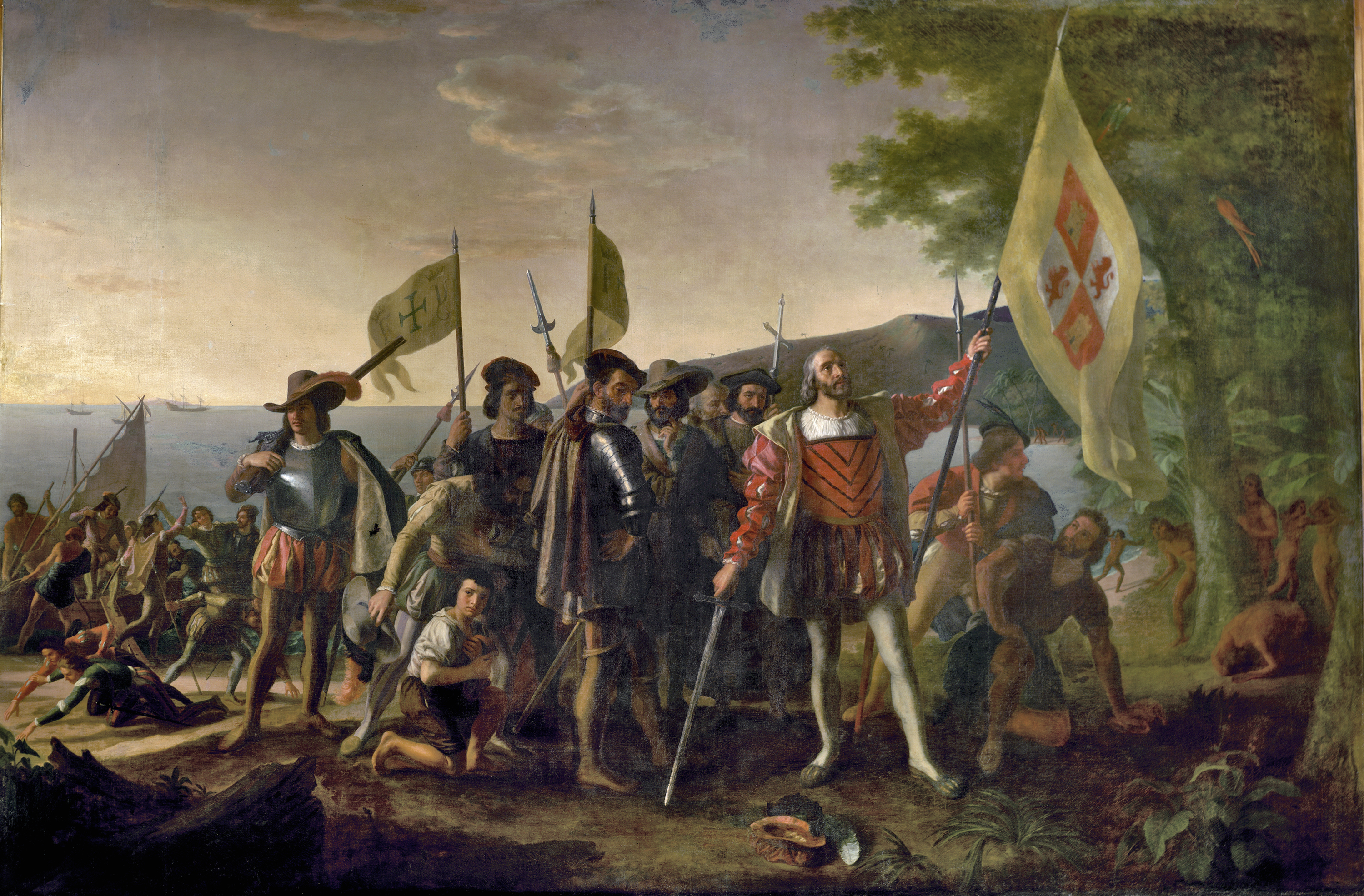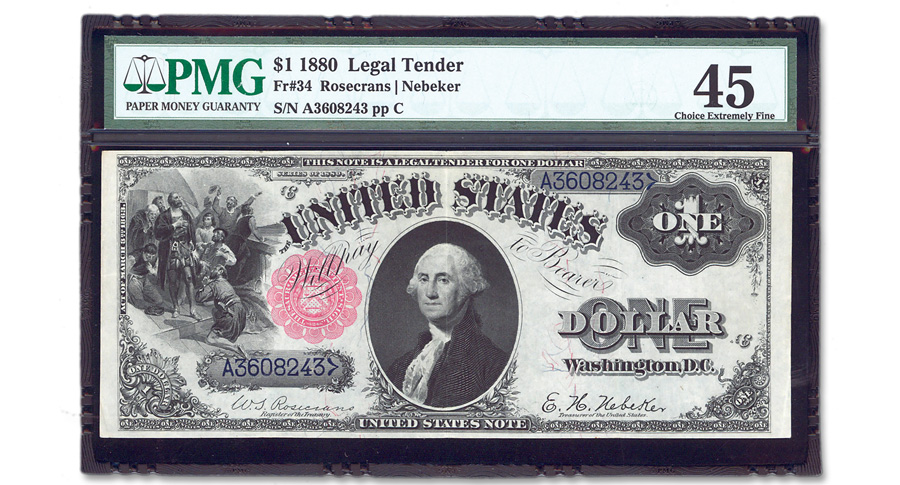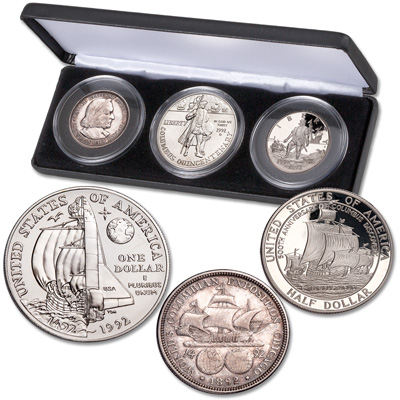Discovering Christopher Columbus on Coins and Currency

“The Landing of Columbus”, John Vanderlyn
It’s been quite an adventure to discover all the different ways in which Christopher Columbus can be found on U.S. money!
In 1863, Congress passed the National Bank Act to create a national banking system, float federal war loans to fund the Union Army in the Civil War, and establish a national currency. The request for design proposals read, in part: “…submissions must be national in their character.”
- In awarding those mid-19th century engraving and printing contracts, three goals were important:
- to foil counterfeiters, each paper note had to be filled with highly complex and colorful engravings
- scenes would show noteworthy events from the still-young nation’s founding history, and
- put as much distance between the country’s hard-fought independence 87 years earlier and its former British rule.
Who better to be represented on currency than an Italian mapmaker and explorer funded by Spain to look for new trade routes to the Orient?
To Washington decision-makers at that time, Columbus symbolized the New World, not the old. His sighting of the Americas mirrored westward expansion; there were only 35 states at the time. Just as the Second Industrial Revolution was about to get started, he was an ideal “founding figure” to put on federal paper money alongside “founding father” George Washington.
From Canvas to Currency

One of the earliest sightings of Columbus on paper currency appears to have been on $1 legal tender notes printed in 1869.The vignette to the left of a portrait of George Washington is from Columbus Discovery of Land, a painting by Philadelphia-based Christian (sometimes called Charles) Schussele in which the explorer’s right hand is placed over his heart. The engraver was Joseph P. Ourdan.
Charles Fenton’s painting Columbus in Sight of Land provided inspiration to engraver Charles Burt. Fenton painted the explorer with his left-hand outstretched, pointing to the horizon line, a notable difference from Schussele’s.
John Vanderlyn painted the explorer on terra firma in The Landing of Columbus, an enormous oil measuring 12’ by 18’ commissioned for the Capitol Rotunda, and Burt engraved that landing for currency. In fact, you can sometimes find both of Burt’s two engravings of Columbus on the same note!
Also known as “horse blankets,” these large-size notes were issued through 1928. They offer collectors the greatest variety of artistic designs, subject matter, history, plus the opportunity to discover Columbus engraved on either the front or back.
By the time of the Wall Street Crash of 1929, the number of notes produced annually by the Bureau of Engraving and Printing was astronomical, and increasing in number. However, production costs for paper and ink were rising. To cut expenses, the bureau reduced the large notes to small notes. And with that decision, Columbus was retired from paper currency.
The Change to Coin

This 3-coin set features designs honoring Christopher Columbus, including the 1892 “Columbian half dollar”.
Before the 19th century closed, Columbus was pressed into service. Not only would a world’s fair celebrate the 400th anniversary of America’s discovery, but a commemorative coin with Columbus on the obverse would be issued to help defray the cost of the 600-acre exhibition in Chicago. So, in 1892, the U.S. Mint struck its first-ever coin to depict a historical person.
Often referred to as “the Columbian half dollar”, it was designed by Olin Lewis Warner and engraved by Charles E. Barber and George T. Morgan. The reverse showed the Santa Maria sailing across rough waters over two hemispheres separated by the year 1492. It was struck in 90% pure silver. It was issued again in 1893 to raise funds for the exposition. In all, 5 million were struck, and remain highly collectible.
One hundred years later, in 1992, the U.S. Mint celebrated the 500th anniversary of Columbus’s epic voyage with a program that included silver dollars and gold coins.
Starting with the new half dollar, designer T. James Ferrell showed Christopher Columbus at landfall on the obverse. In the background is the Santa Maria and a smaller ship with the crew disembarking. On the reverse are the three ships of Columbus’s voyage. It was minted in San Francisco.
The 1992 Columbus Silver Dollar was designed by John Mercanti. The obverse features a full-length portrait of the explorer standing with a banner in his right hand and a scroll in his left. He stands next to a globe and there is a scene of ships and land in the upper portion of the background. The reverse was designed by Thomas D. Rogers, Sr. Struck in Philadelphia, it features a dramatic split image of the Santa Maria and the space shuttle Discovery.
A special $5 gold coin, struck at the West Point Mint, featured the work of both Ferrell and Rogers. For the obverse, Ferrell created a profile of Columbus looking at the eastern shoreline of the western hemisphere. For the reverse, Rogers used the crest of the “Admiral of the Oceans,” the honorific title given to Columbus, and a map overlapping the western Old World with the date 1492.
Collectors who like the pairing of classic coins with modern interpretations have the opportunity to own a three-coin set of Columbus commemoratives, thanks to Littleton Coin Company. Recalling his momentous achievement, this historic set features three one-year-only U.S. commemoratives – struck 100 years apart: an 1892 Columbian half dollar, plus a 1992 clad half dollar and a 90% silver dollar Proof. This set truly is an opportunity to hold history in your hands.




Trying to find out what I have it’s a gold coin gold dallor size that said Christopher Columbus discovery of America on one side other side says the dramatic discovery of a new world America ship on one side and him holing a flag on other
Hi Sandy, I tried to look up what you have based on the wording you said was on the coin, but I came up with nothing. If you can send us a couple of close up photos of the obverse and reverse of your coin, we’d be happy to see if we can help you identify it. You can send your photos to: info@ littletoncoin.com and just put “Attention: Rick” in the subject line. I’m curious to see what you have and look forward to helping you identify it. Have a good day! -Rick
I’ve got one that says 500th anniversary of discovering 1492-1992 America on one sidewinder the statue of liberty. The other side is a portrait of Columbus 1451-1506 with his name and can’t find it in any coin book or on the internet can someone help
Hi Keith, The 1992 Christopher Columbus Commemorative Dollar has an image of the Space Shuttle on the reverse, but I’m not familiar with one that shows the Statue of Liberty. If you’re able to take some photos of the coin, you’re welcome to send them to us and we can have our graders take a look and see if they can tell us something about your coin. You can send your photos by email to info@littletoncoin.com. Have a good weekend!
Thank you for replying . I’ll send photos shortly.